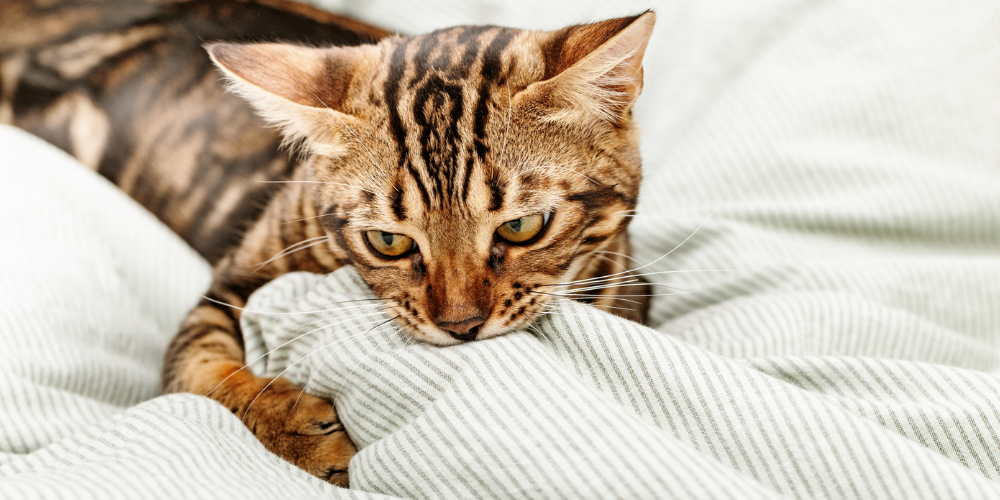Ever find yourself pinned under the spell of your cat’s rhythmic paw presses and soothing purrs? You’re not alone! This delightful and curious behavior—kneading—is something that many cat owners have observed and often pondered about. Known affectionately as “making biscuits,” it’s a behavior deeply embedded in your feline friend’s instinctual repertoire.
Cats purr for a myriad of reasons, ranging from pure contentment to even self-healing. It’s not merely a sound but a comforting vibration that can ease their stress… and perhaps yours too.
So, what’s behind all this kneading and purring? Is it affection, instinct, or something altogether mysterious? Let’s unravel the cozy secrets of your cat’s endearing habits and explore why your lap seems to be their favorite place to knead away their day.
What Is “Kneading”?
Kneading is a common behavior in cats where they push their paws alternately into a soft surface, much like a baker working dough.
This action is often accompanied by a faraway look, suggesting it brings them a deep sense of relaxation and comfort. Cats can knead on just about anything from blankets and pillows to, most adorably, their favorite humans.
The origin of this behavior dates back to kittenhood. Newborn kittens knead their mother’s belly to stimulate milk flow while nursing, which can create lasting positive associations with kneading.
As adult cats, they might carry this behavior into their daily routine, using it as a way to unwind and convey a sense of security. Whether they’re preparing their “sleep space” or showing love, kneading is a cat’s personalized touch of affection.
Why Does My Cat Knead Me?
When your cat kneads you, it’s often a sign of deep comfort and affection. These soft, rhythmic presses with their paws are a way of expressing that they feel safe and secure in your presence.
The roots of kneading go back to kittenhood, where it helped kittens feed. This ingrained behavior carries through into adulthood as a signal of happiness and contentment. When your cat kneads on you, it’s like you’re their cozy nest—a huge compliment!
Additionally, kneading is a method cats use to mark territory. Cats have scent glands in their paws, and by kneading, they’re leaving their unique scent on you, declaring that you’re part of their world.
Finally, kneading can be simply soothing for your cat. It often starts up just before a nap as they settle into a comfortable position. So, when your cat kneads you, enjoy the moment—they’re showing love and a desire to be close.
Cat Kneading Me With Claws: What To Do?
If your cat’s kneading comes with the added surprise of sharp claws, don’t worry—there are gentle ways to cope with this prickly situation.
First, consider keeping your cat’s nails trimmed. Regularly cutting their claws can minimize the poke factor without affecting their ability to knead happily.
You might also offer a soft blanket or pillow for your cat to knead on instead of you. This allows them to enjoy their kneading routine while sparing your skin.
Another option is to gently redirect their paws when they start to knead with claws out. Softly lift their paws and place them back down, encouraging them to retract their claws.
Some owners find that providing praise or treats when their cat kneads gently can reinforce softer behavior over time.
Ultimately, patience is key. Your cat doesn’t mean to cause discomfort—they’re simply showing love in their quirky, feline way.
Should You Stop a Cat From Kneading?
In most cases, there’s no need to stop your cat from kneading. This natural behavior provides comfort and joy to your feline companion.
However, if kneading becomes problematic—like when those tiny claws dig a bit too deep into your skin—gentle redirection is key. Offering a cozy blanket or pillow can serve as a great alternative kneading spot that keeps everyone happy.
Ensure your cat’s nails are trimmed and consider using positive reinforcement to encourage softer kneading. You can gently guide their paws to a more suitable surface and reward them with a treat for their cooperation.
Most importantly, remember that kneading is a positive expression. While it might need a little management, it’s usually best to let your cat enjoy their comforting ritual with minimal interference.
How Do You Get a Cat To Stop Kneading?
Stopping a cat from kneading completely might not be feasible, but you can gently manage where and how they do it.
Start by redirecting their attention to an inviting blanket or pillow. Many cats will happily transition to kneading on a cozy alternative when it’s within reach.
Keeping your cat’s nails trimmed can help lessen discomfort if they insist on kneading you. Additionally, you can try placing a soft towel or blanket on your lap to act as a buffer.
When your cat begins to knead, calmly guide their paws to an appropriate surface. Pair this redirection with gentle praise or a treat to reinforce the new behavior.
If your cat is especially persistent, consider consulting a veterinarian or pet behaviorist for tailored advice. Remember, kneading is a natural expression of comfort, and with a little patience, you can redirect it while maintaining your kitty’s happiness.
The Bottom Line
Cats knead and purr as a way to express comfort, happiness, and a sense of security. It’s an ingrained behavior that signifies trust and affection towards you.
While the occasional claw might catch you off guard, remember that these actions are deeply rooted in their natural instincts. A gentle redirection or a cozy barrier can help manage any discomfort while keeping the bond intact.
Ultimately, kneading and purring are just a couple of the many ways your cat communicates their love. Embrace these moments as signs of the special connection you share. Enjoy the cozy companionship—it’s your cat’s way of saying you’re their safe place.

